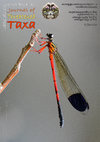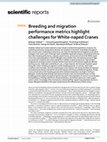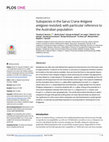Drafts by George Archibald
Papers by George Archibald
Birds of the World, Mar 4, 2020
Birds of the World, Mar 4, 2020

Scientific Reports, Oct 29, 2022
Globally, habitat loss has been deemed a major threat to wetland bird populations. However, the u... more Globally, habitat loss has been deemed a major threat to wetland bird populations. However, the underlying mechanism of population declines and variations in the birds' vulnerability throughout their annual cycle is challenging to determine, yet critical for development of targeted conservation strategies. Over seven years, landscape water availability explained occupancy of breeding territories best when breeding performance, migratory performance, and annual survival of the White-naped Crane (Grus vipio) population in eastern Mongolia were studied. Also, the hatching success of eggs was positively correlated with water availability in addition to plant productivity. High ambient temperatures and large numbers of herder families (and hence more livestock) negatively affected hatching success. High water availability at Luan, a major stopover site increased migration speed during the cranes' northbound migration to their breeding grounds. In contrast, when water conditions were favorable, the birds stayed longer at the stopover site during southbound migration. Increased human density reduced the use of the stopover site during northbound migration. Finally, cranes arrived early at the breeding grounds when ambient temperature was high in northeast Mongolia. Combining these findings with historical trends in key environmental factors on their breeding grounds explains the general decline observed in this population of cranes in recent decades. Extrapolating our findings with future climate predictions, the outlook seems poor unless urgent action is taken. Knowledge of the mechanisms underlying White-naped Crane population decline in eastern Mongolia identified in this paper should improve the effectiveness of these actions. About one third of all global natural wetlands have disappeared over the last four decades due to climate change and other anthropogenic effects 1,2. In East Asia environmental changes have included ongoing loss of wetlands accelerated by unprecedented socioeconomic development 3,4. These wetland degradations are thought to impact millions of waterbirds, causing population declines in both resident and migratory species 5-7. Although studies have identified the associations between population declines and wetland degradation, the underlying mechanisms leading to these declines remain unclear. The three mechanisms most commonly proposed include reduced breeding performance (i.e., low recruitment due to low nesting, hatching, or fledging rates), reduced migratory performance (i.e., changes in departure and arrival dates, migration duration, number of stops), and low annual survival (i.e., juvenile and adult). Decrease in breeding performance due to deterioration of nesting and foraging habitat at the breeding grounds is considered a primary cause of waterbird population declines 8,9. Many waterbirds rely on aquatic plants as nest material and cover, without which nests become prone to predation 10 , trampling 11 , and extreme weather events 12. Low food availability may result in reduced clutch size 13 and nest attendance 14 , and increasing nest failure rates 15. For many waterbirds, migration is another essential part of the annual cycle that may be impacted by deteriorating environmental conditions 16. Loss of wetlands is thought to reduce refuelling opportunities during waterbird migration 5,17. Refuelling at spring staging sites is critically important for replenishing energy reserves as it can determine fecundity 18-20. Many studies have shown that migratory birds adjust their migration in response to conditions en-route 21,22 , by either delaying or advancing their migration timing 23-26 with potential carry over effects on their breeding performance 27 and population dynamics 28 .

Journal of Threatened Taxa, Jun 26, 2022
The Wattled Crane is listed as Vulnerable on the IUCN Red List, and isolated population occurs in... more The Wattled Crane is listed as Vulnerable on the IUCN Red List, and isolated population occurs in Ethiopia. This study was conducted in Chimba wetlands, Lake Tana area from October-2013 to December-2014. The objectives were to understand the distribution and population status of the Wattled crane and assess the vegetation characteristics and threats of the ecological units. The population size and density of cranes in the study area was determined from weekly counts carried out in equal-sized sampling units. The total survey area was divided into square grids, and each of them was 1.23 square km wide/size. A total of 10 grid squares, which have an area of 12.32 square km were considered for density analysis. Although the total area of the study was 208.2 km 2 , unsuitable habitats, such as forest or farmlands were excluded. Counts of cranes were made at known sites. The density was calculated as the average number of cranes counted per unit area. A total of 32 cranes were recorded. The density of cranes in the study area is 2.6 per km 2. Cranes were located in Addis Amba, Dehena Mesenta, Latamba, and Legdia local administrative areas. The number recorded in each area varied, the largest (17) was recorded in Latamba Kebele and the fewest (2) in Legdia. The dominant vegetation type of Chimba wetlands is emergent macrophyte. However, the papyrus bed represents about 10% of the wetland. Species of vegetation other than papyrus bed is represented by a 20 quadrat study. A total of 26 macrophyte species belonging to 10 families were recorded. Intensive cultivation, draining of the wetland, habitat degradation, overgrazing of the wetland, overharvesting of papyrus, invasive species, and over-flooding are the major threats of wetlands.
Authorea (Authorea), Apr 26, 2023

Scientific Reports
Globally, habitat loss has been deemed a major threat to wetland bird populations. However, the u... more Globally, habitat loss has been deemed a major threat to wetland bird populations. However, the underlying mechanism of population declines and variations in the birds’ vulnerability throughout their annual cycle is challenging to determine, yet critical for development of targeted conservation strategies. Over seven years, landscape water availability explained occupancy of breeding territories best when breeding performance, migratory performance, and annual survival of the White-naped Crane (Grus vipio) population in eastern Mongolia were studied. Also, the hatching success of eggs was positively correlated with water availability in addition to plant productivity. High ambient temperatures and large numbers of herder families (and hence more livestock) negatively affected hatching success. High water availability at Luan, a major stopover site increased migration speed during the cranes’ northbound migration to their breeding grounds. In contrast, when water conditions were favo...
... Belearica regulorum) 2.3 Demoiselle Crane (Anthropoides virgo) 2.4 Blue Crane (Anthropoides p... more ... Belearica regulorum) 2.3 Demoiselle Crane (Anthropoides virgo) 2.4 Blue Crane (Anthropoides paradisea) 2.5 Wattled Crane (Bugeranus carunculatus) Ann Burke 2.6 Siberian Crane (Grus leucogeranus) 2.7 Sandhill Crane (Grus canadensis) 2.8 Sarus Crane (Grus antigone ...
Journal of Ecological Society
area of submergence for waterfowl use. They will be planted with Acacia nilotica trees and aquati... more area of submergence for waterfowl use. They will be planted with Acacia nilotica trees and aquatic grasses as waterfowl shelter. As the acacia grows it may provide nesting trees to waterfowl. 5. These mounds are also expected to provide niches where aquatic life including fish can find shelter and breeding places. The aim is to provide a self-sustaining food web that will replace the simplified unidirectional food chain operating at present. This is shown in the accompanying figure.

African Zoology
Birds select breeding habitats based on biotic and abiotic environmental factors, resulting in a ... more Birds select breeding habitats based on biotic and abiotic environmental factors, resulting in a non-random spatial distribution of nests. This study investigated the onset of nesting, nest location, the relationship between nest height and water depth, nest materials, and the structure and characteristics of Black Crowned Crane nests in the Lake Tana region, Ethiopia. A total of 52 nests were recorded in four wetlands from 2014 to 2015. Nesting activity predominantly took place from September to October. There was a significant difference in the distance from nests to the edge of the wetland (χ 2 = 24.843, n = 46, df = 3, p < 0.001). However, in all study areas the distance between nests, which indicates the degree of territoriality, did not show any significant difference (χ 2 = 6.016, n = 34, df = 3, p = 0.111). In addition, nests were constructed in the wetland where the water depth ranged from 80 to 220 cm. Nest height (H 2i) and water depth (WD i) at nesting sites were highly correlated, and the regression equation (H 2i = 13.77 + 1.03WD i) indicated that when the water depth increases, the nest height also increases. The shallowest depth where a nest was constructed was 80 cm. Vegetation type varied, but cranes used Leersia hexandra, Oryza longistaminata, and Cyprus rotundus plants as their selected nesting material. The average vegetation height observed at nests with eggs, measured one metre away from the nest rim, ranged from 20 to 90 cm (44.83 ± 2.397), n = 48. The vegetation height at each study site showed no significant difference (F (3) = 2.527, p = 0.07). The mean nest length, width, and height from the surface of the water between nests were not significantly different. Nesting density was variable depending on the size of the wetland, water depth, and vegetation type and cover.

The aim of the study was to investigate the abundance, density and cluster size of Black Crowned ... more The aim of the study was to investigate the abundance, density and cluster size of Black Crowned Cranes. Seventy four and 56 transects were examined in 14,764 ha of land in 2015 (wet season) and 2016 (dry season), respectively. Multiple Covariate Distance Sampling model was employed. The encounter rate, detection probability, expected cluster size and density were parameters for estimation. Hazard rate key (σ=0.3), detection function g(x)=1-exp[-(x/σ) ^(-β)], x≤w was selected for analysis. Cluster analysis based on exact sizes was computed by regression of log(s(i)) on g(x(i)). The minimum Akaike Information Criterion was chosen during estimator selection. The result showed that the cluster size of cranes during the wet season in wetland and farmland habitats regression estimate were Cwi=0.73+0.16*xi; and Cfi=0.52+-0.21*xi, respectively. Similarly, in 2016, the regression estimate of wetland and farmland were Cwi=0.16+0.56*xi and Cfi=0.20+-0.34*xi, respectively. During the wet seaso...
... Say, he asked Hammy, Can I buy some of them young birches from you? What do you want the... more ... Say, he asked Hammy, Can I buy some of them young birches from you? What do you want them for? People want birch trees. I dig 'em and plant 'em. Most of 'em live. Fran knew of Hammy's plan to burn those birches. She held her breath. ...

Four species of crane occur in Ethiopia, making the country the most important in Africa for cran... more Four species of crane occur in Ethiopia, making the country the most important in Africa for cranes. Black-crowned Balearica pavonina and Wattled Cranes Bugeranus carunculatus, both listed as Vulnerable, are resident species, while Common Grus grus and Demoiselle Cranes Anthropoides virgo, both listed as Least Concern, are migrants. We assessed the distribution and minimum population size of four crane species at the most important and main crane sites during 2007–2019. Some potentially important sites, particularly for Black-crowned Cranes, were not able to be surveyed. Breeding areas of resident cranes were also surveyed. Results showed that Black-crowned Cranes were mainly distributed in the Gambela and Lake Tana areas and the minimum population estimate was 3319 individuals. Wattled Cranes were distributed in Bale Mountains National Park, Lake Tana, Jimma wetlands, Bonga and central Rift Valley areas and the minimum population estimate was 366. Migratory Common Cranes were found...

PLOS ONE, Apr 16, 2020
Subspecies are often less well-defined than species but have become one of the basic units for le... more Subspecies are often less well-defined than species but have become one of the basic units for legal protection. Evidence for the erection or synonymy of subspecies therefore needs to be founded on the best science available. Here we show that there is clear genetic disjunction in the Sarus Crane Antigone antigone, where previously the variation had appeared to be clinal. Based on a total sample of 76 individuals, analysis of 10 microsatellite loci from 67 samples and 49 sequences from the mitochondrial control region, this research establishes that the Australian Sarus Crane A. a. gillae differs significantly from both A. a. antigone (South Asia) and A. a. sharpii (Myanmar and Indochina). A single sample from the extinct Philippine subspecies A. a luzonica clustered with A. a. gillae, hinting at the potential for a more recent separation between them than from A. a. antigone and A. a. sharpii, even though A. a. sharpii is closer geographically. The results demonstrate that failure to detect subspecies through initial genetic profiling does not mean discontinuities are absent and has significance for other cases where subspecies are dismissed based on partial genetic evidence. It could also be potentially important for sourcing birds for reintroduction to the Philippines.

In 1982, 2 eggs from an abandoned greater sandhill crane (Crus canadensis tabUla) nest were artif... more In 1982, 2 eggs from an abandoned greater sandhill crane (Crus canadensis tabUla) nest were artificially incubated and hatched. Chicks were hand reared in partial visual isolation from humans with the aid of puppet heads. At 4-5 weeks of age, the chicks were placed in a fenced compound in a marsh frequented by their parents. During daylight hours the chicks were continually monitored by an observer in a blind. Until fully feathered, they were returned at night to an indoor shelter. Upon fledging, the chicks were released daily in the field where their parents foraged. The adults and the chicks were mildly attracted to each other. In late August, immediately after being color-marked, the chicks disappeared from the study area. Their parents remained in the region until mid-October. During winter 1984-85, 1 of the released birds was observed with other greater sandhills in northcentral Florida. The same bird was observed once during the summer of 1985 at the release site. It was accom...











Uploads
Drafts by George Archibald
Papers by George Archibald